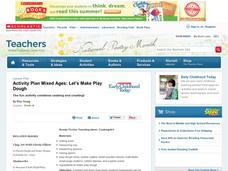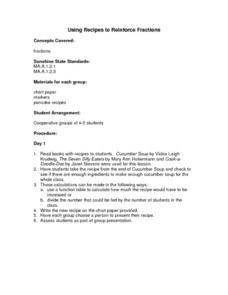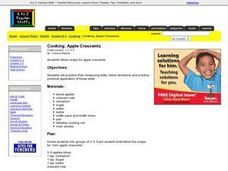Curated OER
What's Cooking at the Good Times Cafe?
Students collect data from classmates showing their favorite lunch food. They enter their data and graph the results using a computer program.
Curated OER
Prime Real Estate
Students analyze and discuss prime numbers and the Sieve of Eratosthenes, a procedure to sort out prime numbers. They identify the prime numbers from 1-100 by eliminating all the multiples of the first four prime numbers, and circle what...
Curated OER
Following a Recipe
Learners create a cookbook. In this recipe and writing lesson, students brainstorm the skills necessary to follow a recipe, watch a cooking show and write down a recipe used. Learners use a word processing program to write a...
Curated OER
Holy Mole
Students discover Mexican culture by reading and cooking. In this Central American History lesson, students read the book Holy Mole, and analyze the story by answering questions about plot, characters and even sound effects they...
Curated OER
Reciipes Made for More
Students write recipes. In this recipe lesson plan, students double and triple recipes. They perform calculations with fractions, whole numbers and mixed numbers. They explore cooking websites to find their favorite...
Curated OER
Corn Field Math
Middle schoolers complete problems dealing with whole numbers, fractions and percents. After exploring the history of corn and related farming vocabulary, students work in pairs to solve multi-step problems. They incorporate the use of...
Curated OER
Tzedakah: How Can We Help?
Students define what constitutes a nutritious meal, the price of a healthy meal, and understand that some people can't afford healthy meals. In this healthy meals lesson plan, students estimate and research the cost of a nutritious meal,...
Curated OER
When Turtle Grew Feathers
Students explore the theme of friendship as it relates to the story When Turtle Grew Feathers. In this friendship lesson plan, students discuss friendship, answer comprehension questions, and create their own friendship story.
Curated OER
Let's Make Play Dough
Students create their own play dough to use for art projects. In this art lesson, students measure, pour and mix the ingredients to make their own play dough. Then, students use the clay to create their own sculptures.
Alabama Learning Exchange
Good Litter, Bad Litter
Which ones can be thrown on the ground? Discover the difference between natural litter and unhealthy trash, helping scholars by using several examples. Use the information here to give them a basic background, but also encourage prior...
WakeGOV
Plastic Sight Words
Plastic math? Have young learners count and name the number of plastic items in their centers. Kindergartners match sight word cards to the number of plastics in a given group, while learning that plastics come in all different shapes,...
Perkins School for the Blind
Grocery Shopping
Grab those reusable bags, it's time to go shopping! Intended to foster independent living skills in learners with visual impairments, the lesson covers several topics related to grocery shopping. They start by planning a meal, reading...
Lee & Low Books
First Come the Zebra Teacher’s Guide
Accompany a reading of First Come the Zebra written and illustrated by Lynne Barasch with a teacher's guide equipped with before reading, vocabulary, and after reading activities. Additional social studies,...
Curated OER
Chef for a Day
Students make chocolate chip cookies. In this cooking activity, students follow a recipe by doing each step in sequence.
Curated OER
If You Can’t Stand the Heat
Students design and build their own solar cooker. In this math lesson, students determine the relationship between the angles of the sun, reflection and cooking time of the solar cooker. They test their project, collect data and...
Curated OER
Carrot Bunch
Second graders solve a variety of math addition word problems related to planting and cooking carrots. They discuss a story from their math storybook, then read and solve a carrot word problem on a worksheet as a class. Students then...
Curated OER
Bake, Boil, or Fry
Students write a journal entry about where there food comes from. In this Civil War lesson, students discuss journals, the crops grown within the U.S., the import/export process and what food preparation must have been like on a...
Curated OER
Class Ketchup
Students describe statistics by conducting a class cooking activity. In this ketchup lesson plan, students conduct a class survey based on ketchup consumption habits by students. Students utilize tomatoes, water and a bottle to create...
Curated OER
Using Recipes To Reinforce Fractions
Young scholars calculate fractions used in various food recipes in this Math lesson with real world applications. The lesson is geared towards upper elementary students but can be adapted for various levels of learners. State math...
Curated OER
Closure Lesson - Planning for the Trip
Students prepare for a camping trip. In this camping trip planning instructional activity, students work in small groups as they discuss their expectations for their upcoming trip. They receive and plan for a specific task such as...
Curated OER
It's Alive! Using Microorganisms in Cooking
Learners create a KWL chart about food. In this chemistry lesson, students differentiate physical and chemical changes. They explain how microorganisms are used in food preparation.
Curated OER
Cooking: Apple Crescents
Student apply their measurement skills and follow a recipe to make apple crescents.
Curated OER
What Comes From Corn
Learners name and examine various items that are made from corn. Students compare ears of corn to Indian corn, and cook several items made from corn. Learners create a popcorn picture and illustrate a book.
Curated OER
Math Bargains
First graders use real coins or concrete models of coins to solve problems involving the purchase of items. They use cons and simulate going to a bargain store to purchase items. Students record the total cost of items. Pupils make a...























